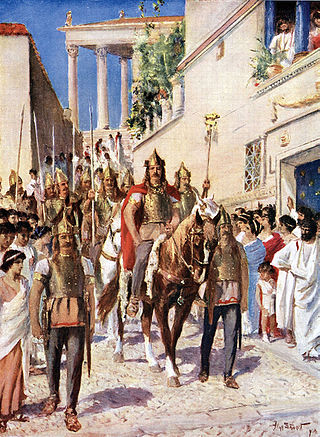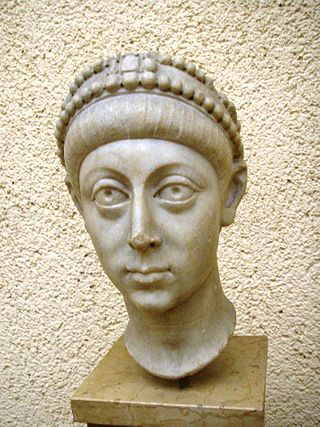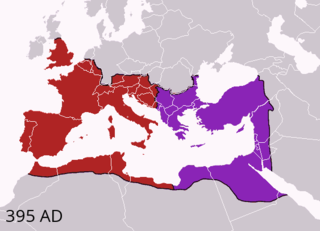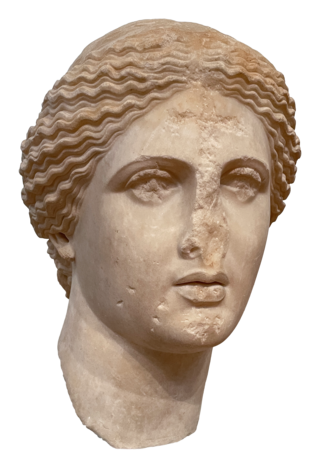
Alaric I was the first king of the Visigoths, from 395 to 410. He rose to leadership of the Goths who came to occupy Moesia—territory acquired a couple of decades earlier by a combined force of Goths and Alans after the Battle of Adrianople.

Arcadius was Roman emperor from 383 to his death in 408. He was the eldest son of the Augustus Theodosius I and his first wife Aelia Flaccilla, and the brother of Honorius. Arcadius ruled the eastern half of the empire from 395, when their father died, while Honorius ruled the west. In his time, he was seen as a weak ruler dominated by a series of powerful ministers and by his wife, Aelia Eudoxia.

Honorius was Roman emperor from 393 to 423. He was the younger son of emperor Theodosius I and his first wife Aelia Flaccilla. After the death of Theodosius in 395, Honorius, under the regency of Stilicho, ruled the western half of the empire while his brother Arcadius ruled the eastern half. His reign over the Western Roman Empire was notably precarious and chaotic. In 410, Rome was sacked for the first time since the Battle of the Allia almost 800 years prior.
The 400s decade ran from January 1, 400, to December 31, 409.

Year 395 (CCCXCV) was a common year starting on Monday of the Julian calendar. At the time, it was known as the Year of the Consulship of Olybrius and Probinus. The denomination 395 for this year has been used since the early medieval period, when the Anno Domini calendar era became the prevalent method in Europe for naming years.

Year 412 (CDXII) was a leap year starting on Monday of the Julian calendar. At the time, it was known in Europe as the Year of the Consulship of Honorius and Theodosius. The denomination 412 for this year has been used since the early medieval period, when the Anno Domini calendar era became the prevalent method in Europe for naming years.

Year 401 (CDI) was a common year starting on Tuesday of the Julian calendar. At the time, it was known as the Year of the Consulship of Vincentius and Fravitus. The denomination 401 for this year has been used since the early medieval period, when the Anno Domini calendar era became the prevalent method in Europe for naming years.

Year 400 (CD) was a leap year starting on Sunday of the Julian calendar. In the Roman Empire, it was known as the Year of the Consulship of Stilicho and Aurelianus. The denomination 400 for this year has been used since the early medieval period, when the Anno Domini calendar era became the prevalent method in Europe for naming years.
The 390s decade ran from January 1, 390 to December 31, 399

Stilicho was a military commander in the Roman army who, for a time, became the most powerful man in the Western Roman Empire. He was partly of Vandal origins and married to Serena, the niece of emperor Theodosius I. He became guardian for the underage Honorius. After nine years of struggle against barbarian and Roman enemies, political and military disasters finally allowed his enemies in the court of Honorius to remove him from power. His fall culminated in his arrest and execution in 408.

The fall of the Western Roman Empire, also called the fall of the Roman Empire or the fall of Rome, was the loss of central political control in the Western Roman Empire, a process in which the Empire failed to enforce its rule, and its vast territory was divided among several successor polities. The Roman Empire lost the strengths that had allowed it to exercise effective control over its Western provinces; modern historians posit factors including the effectiveness and numbers of the army, the health and numbers of the Roman population, the strength of the economy, the competence of the emperors, the internal struggles for power, the religious changes of the period, and the efficiency of the civil administration. Increasing pressure from invading peoples outside Roman culture also contributed greatly to the collapse. Climatic changes and both endemic and epidemic disease drove many of these immediate factors. The reasons for the collapse are major subjects of the historiography of the ancient world and they inform much modern discourse on state failure.
The Battle of Pollentia was fought on 6 April 402 between the Romans under Stilicho and the Visigoths under Alaric I, during the first Gothic invasion of Italy (401–403). The Romans were victorious, and forced Alaric to retreat, though he rallied to fight again in the next year in the Battle of Verona, where he was again defeated. After this, Alaric retreated from Italy, leaving the province in peace until his second invasion in 409, after Stilicho's death.

The sack of Rome on 24 August 410 AD was undertaken by the Visigoths led by their king, Alaric. At that time, Rome was no longer the administrative capital of the Western Roman Empire, having been replaced in that position first by Mediolanum in 286 and then by Ravenna in 402. Nevertheless, the city of Rome retained a paramount position as "the eternal city" and a spiritual center of the Empire. This was the first time in almost 800 years that Rome had fallen to a foreign enemy, and the sack was a major shock to contemporaries, friends and foes of the Empire alike.

Uldin, also spelled Huldin is the first ruler of the Huns whose historicity is undisputed.

Anthemius was a statesman of the Later Roman Empire. He is notable as a praetorian prefect of the East in the later reign of Arcadius and the first years of Theodosius II, during which time he led the government of the Eastern Roman Empire on behalf of the child emperor and supervised the construction of the first set of the Theodosian Walls.

Aemilia Materna Thermantia was the second Empress consort of Honorius, Western Roman Emperor.

The anti-paganism policies of the early Byzantine Empire ranged from 395 till 567. Anti-paganism laws were enacted by the Byzantine Emperors Arcadius, Honorius, Theodosius II, Marcian and Leo I the Thracian. They reiterated previous legal bans, especially on pagan religious rites and sacrifices and increased the penalties for their practice. The pagan religions had still many followers but they were increasingly obliged to keep under cover to formally comply with the edicts. Significant support for paganism was present among Roman nobles, senators, magistrates, imperial palace officers, and other officials.

The Eastern Roman Empire was ruled by the Theodosian dynasty from 379, the accession of Theodosius I, to 457, the death of Marcian. The rule of the Theodosian dynasty saw the final East-West division of the Roman Empire, between Arcadius and Honorius in 395. Whilst divisions of the Roman Empire had occurred before, the Empire would never again be fully reunited. The reign of the sons of Theodosius I contributed heavily to the crisis that under the fifth century eventually resulted in the complete collapse of the western Roman court.

Eucherius was the son of Stilicho, the magister militum of the Western Roman Empire, and Serena, a Roman noblewoman who was the niece of Eastern Roman Emperor Theodosius I. He was born in c. 388 in Rome, Italy. Despite being the son of the magister militum, Eucherius did not rise farther than the modest rank of tribune of the notaries. Stilicho was accused by his political opponents of plotting to install Eucherius as a third emperor in Illyricum, and as a result of this Stilicho was arrested and executed on 22 August 408, and Eucherius soon after.
The history of the Later Roman Empire covers the history of the Roman Empire from the beginning of the rule of Diocletian in 284 AD and the establishment of the Tetrarchy in 293 AD by Diocletian to the death of Heraclius in 641 AD.















